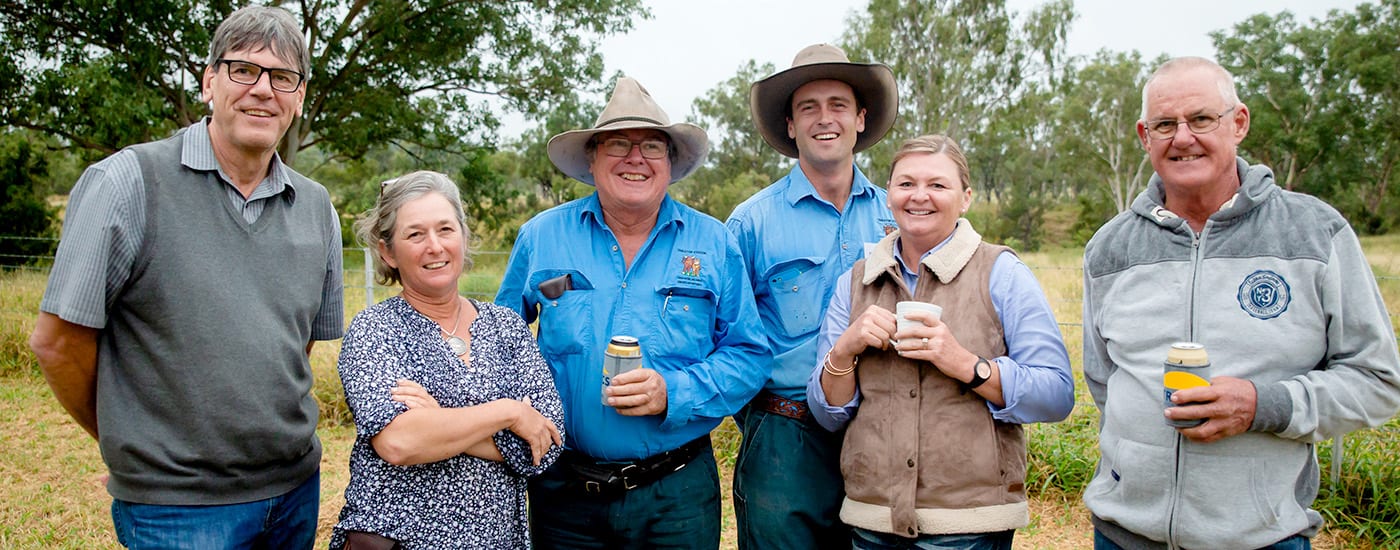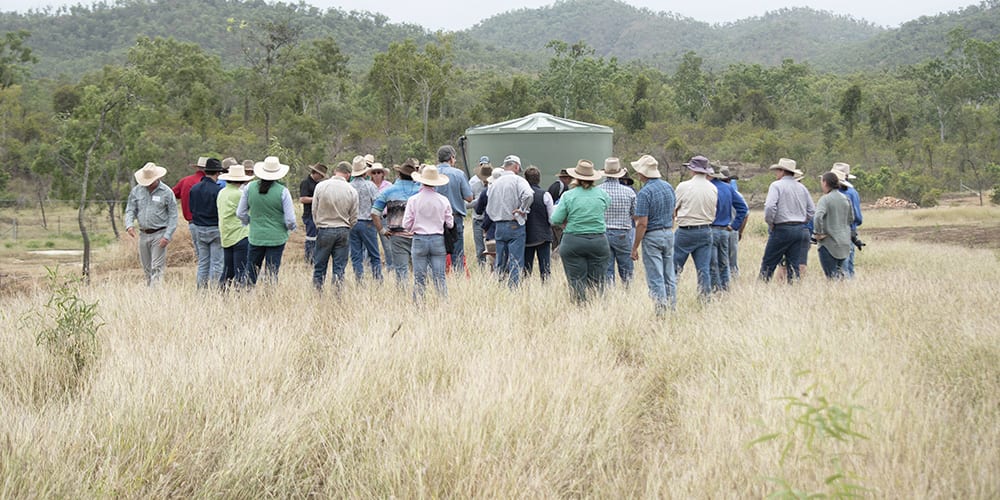Enjoying a catch up following the site visits at Tabletop Station are LDC project panel members, (from left): Christian Roth, CSIRO; Garlone Moulin, Mt Pleasant Station; Tom Murphy, Tabletop Station; Bristow Hughes, Strathalbyn Station; Lisa Hutchinson, LDC project manager; and Bob Harris, Glencoe Station.
LDC supports Stomping out Sediment field days
The LDC project builds on, and aligns with, existing local initiatives in the BBB catchment. One of those initiatives is the NQ Dry Tropics’ Stomping Out Sediment project, and LDC supported its recent field day.
Demonstration sites provide a platform to introduce new ideas and allow landholders to experience innovative practices firsthand.
Well-presented demonstrations can play a critical role in enabling adoption.
When landholders can see for themselves that something works, they are more likely to try it.
The NQ Dry Tropics’ Stomping Out Sediment project sites in the BBB catchment are trialling different methods to remediate gullies and unproductive land, and for improving pasture cover.
That’s why the LDC project encourages landholders to attend a wide range of field days and training activities to learn more about innovative practices that can help improve land, water quality, and productivity.
Big turnout for two-days of property visits focusing on erosion and productivity
The NQ Dry Tropics’ Stomping out Sediment project is investigating a range of options for improving grass cover to manage erosion and increase productivity, while also trying different methods for fixing gullies and remediating erosion sites.
More than 50 graziers, technical experts and scientists attended a two-day field day in May, visiting two properties that are taking part in the project – Tabletop Station, and Strathalbyn Station – both located near Collinsville.
Fast facts:
- Two-day field trip to Tabletop and Strathalbyn stations, near Collinsville
- Tom Murphy, of Tabletop, and Bristow Hughes, of Strathalbyn, are grazier representatives on the LDC project panel
- 53 people attended the field trip
- Graziers came from Bowen, Collinsville, Airlie Beach, George Town, Charters Towers, Mareeba and Clermont
- Representatives from Greening Australia, DAF, CSIRO, RCS Consulting, Dalrymple Landcare, Northern Gulf NRM, Terrain NRM, NQ Dry Tropics NRM attended
- A caravan of 21 4WDs travelled to the two properties
- Dr Christine Jones, Amazing Carbon, in-field soil expert during the field days
- Department of Agriculture and Fisheries (DAF) principal grazing extension officer Bob Shepherd has provided technical support to the project through his knowledge of diversion banks to divert water away from gully heads, and diversity of pasture species
- Grazing management consultants Brian Wehlburg, Inside Outside Management, and Dick Richardson, Grazing Naturally, are providing technical support and extension services to the project through their experience in the use of cattle impact in restoration of gullies and degraded grazing lands
- Graziers including Barry and Leanne O’Sullivan, Glenalpine Station, Jamie Gordon and Garlone Moulin, Mt. Pleasant Station, and Rod Barrett, Salisbury Plains Station, have project relevant land management expertise, and are providing peer to peer grazier support.
Stomping Out Sediment In The Burdekin
Funded through Australian Government Reef Trust Phase IV investment to help deliver the Reef 2050 Long Term Sustainability Plan, NQ Dry Tropics will work with up to 10 grazing properties in targeted Burdekin catchments during five years, starting in July 2017. The project is for the long-term protection and conservation of the Great Barrier Reef.
The Stomping out Sediment in the Burdekin project encourages grazier participation in implementation of gully management strategies to reduce sediment movement from properties.
The project will test and demonstrate the application of grazing treatments and elements of the Gully and Streambank Toolbox in the management of pervasive erosive processes, for curtailing early gully development and for remediation of small to medium size active gullies accessible to cattle, for example, remediating the gullies that graziers often say they should do something about but don’t and gullies in the early stages of development (later becoming the gullies which are too large to remediate without costly interventions).
The project will adopt a staged approach to implementation across the life of the project, starting with five initial landholders, who will increase their levels of gully remediation activity through planned implementation of works, while engaging up to an additional five landholders to undertake project activities.
The objectives of the project are to implement an innovative and practical gully management approach, using on property livestock, to:
- Remediate gullies on productive soils across the co-operating properties
- Test/develop suitable techniques for use on a wider range of soil types (such as dispersive/sodic) and gully structures.
- Encourage spatially connected properties to adopt successful techniques.
- Monitor, document and communicate successful implementation of the approach for broader adoption in other projects and across the Burdekin.
- Provide training opportunities for graziers to better understand practical and cost effective methodologies to remediate gully systems.
Initial project landholders are the Hughes family, Strathalbyn Station, Collinsville, the Murphy family, Tabletop Station, Collinsville and the Pepper family, Terry Creek Station, Bowen, Mark and Debbie Perkinson, Five Mile Station, Bowen, and Barry and Leanne O’Sullivan, Glenalpine Station, Bowen.
Two project areas at Tabletop Station
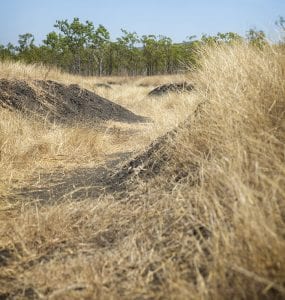
AT Tabletop Station, there are two demonstration sites, a one kilometre long black soil gully, and the second site is on a complex of gullies and scalds on a sodic soil.
Both project areas are around 50ha in area and a range of grazing treatments and remediation techniques are being trialled.
On the black soil site a 1.3km diversion bank was constructed to take water away from the six active gully heads. The diversion bank created considerable discussion at the field day due to ongoing maintenance requirements and the volume of water re-directed to a ridgeline disposal area.
The gully heads have stabilised and grassed over with a program of planned grazing, with high numbers of livestock grazing for a short period twice each year having no negative impact on the gullies.
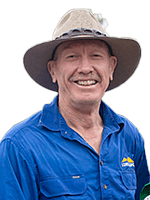
NQ Dry Tropics Project Officer Rod Kerr
Project manager, Rod Kerr, said it was a significant outcome from the project as the general recommendation was that livestock should be excluded from gully sites.
“The trial result to date is supporting the notion that it is possible to have a productive, but managed grazing regime and still get a positive outcome for managing an active gully on black soils,” Mr Kerr said.
“The critical factor will be maintaining good ground cover in and around the gullies at the end of the dry, so that early storms don’t compromise site stability.”
Sodic soil site
At the Tabletop sodic soil site, a 300m diversion bank was constructed to take water away from the active gully heads with water “spreader banks” also constructed to hold the diverted water in the landscape.
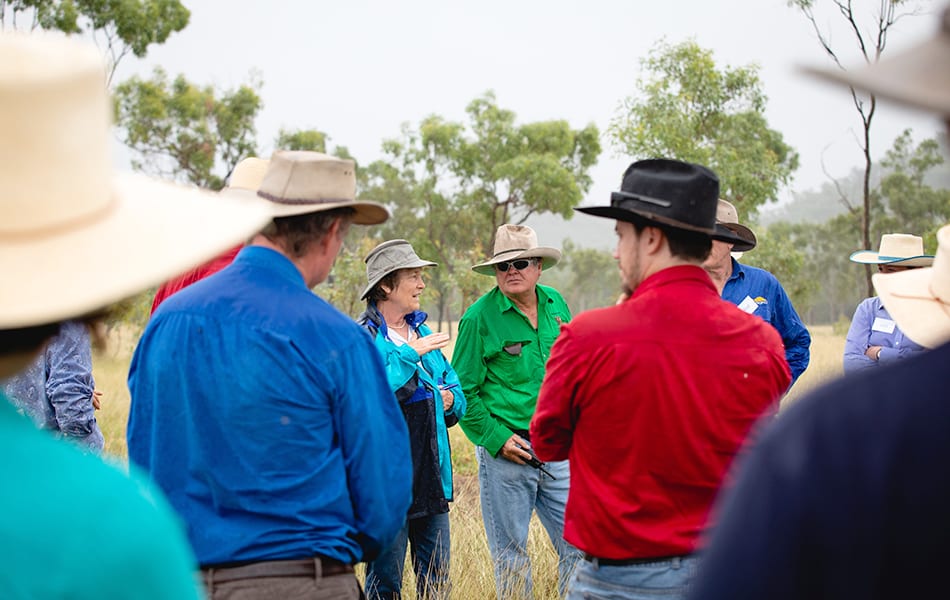
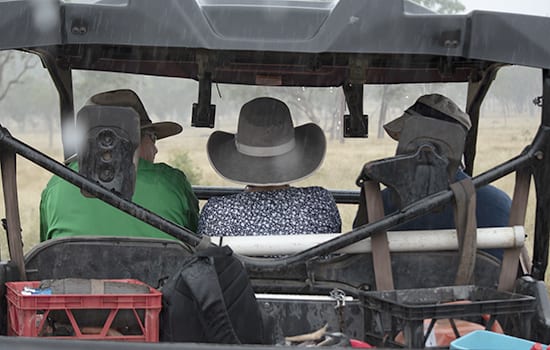 These have grassed up well following the broadcasting of a diverse pasture seed mix and have worked very well in holding and spreading the water across two wet seasons.
These have grassed up well following the broadcasting of a diverse pasture seed mix and have worked very well in holding and spreading the water across two wet seasons.
A trial area was also ripped and re-seeded to slow water flowing onto the site.
The rip-lines now support vigorous butterfly pea and a number of stylos but the sown grass species did not establish well.
The project area was also subject to a number of grazing treatments including a short duration graze (a total of 5000kg/ha of mixed Indian couch, native and stylo pasture was produced on one of the monitoring sites last season), as well as a trial of very high numbers of livestock for a short period to see if this would assist to remediate a 1ha scald site.
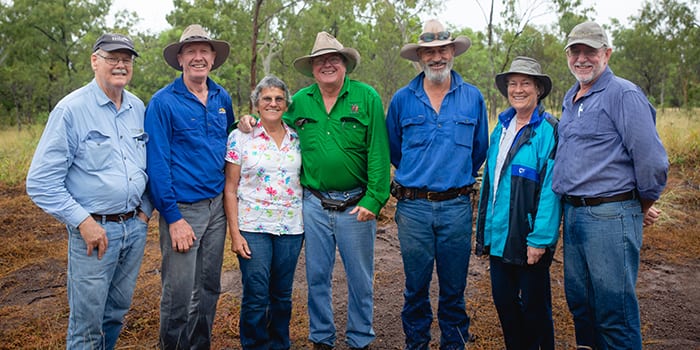
During the field day at Tabletop Station are (from left) Bob Shepherd, DAF; Rod Kerr, NQ Dry Tropics Project Officer; graziers Karen and Tom Murphy, Tabletop Station; Dick Richardson, Grazing Naturally; Dr Christine Jones, Amazing Carbon; and Brian Wehlburg, Inside Outside Management.
A notable outcome from one of the field day stops at Tabletop Station was a former scalded site which is now fully recovered.
The site was heavily stocked for a short period about five years ago then given a long recovery period. It has since been grazed for short periods and given long wet season spelling.
Plants dug up at the site showed healthy root systems and there was good ground cover across the whole site.
Tackling rubber vine and prickly acacia
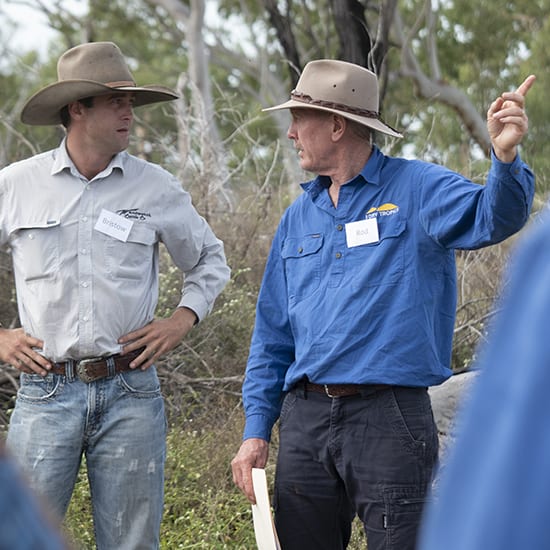
NQ Dry Tropics project officer Rod Kerr (right) and Strathalbyn Station grazier Bristow Hughes
THE visit to Strathalbyn Station took in several demonstration sites including an area that the Hughes’ family had treated with an Ellrott plough to manage dense rubber vine and prickly acacia on a black soil plain.
This treatment appeared to be highly cost effective with follow up spraying for regrowth cleaning up the weed infestation. The approach will be trialled in a new project area which is also covered in rubber vine but has widespread erosion under the weed cover.
Of particular interest was the lack of germination of pasture grasses which were broadcast during the Ellrott plough operation. The large seeded forage sorghums established well but only an odd plant of Rhodes grass of the diverse seed mix was observed.
On the day, Department of Agriculture and Fisheries (DAF) staff collected a wide range of native annual and perennial grasses and forbs which had established.
Soil expert Dr Christine Jones, Amazing Carbon, pointed out that the soil appeared to be biologically inactive and that some more pioneering species in the mix (an example was sunflowers) might have got things moving a bit more.
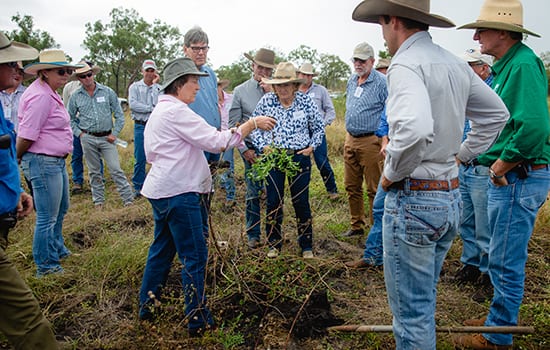
Dr Christine Jones
A demonstration site on another black soil flat is trialling the use of high numbers of livestock for a short period aimed at re-establishment of pasture on bare soil and knocking the steep sides off a number of small gullies.
At this site, a 4ha plot was fenced to exclude livestock since October 2017 and an 8ha plot had over 1100 cows and calves introduced for 24hrs in March 2018, followed by 900 cows for 24hrs in January 2019.
The aim was to create disturbance for a seedbed and provide dung and urine to increase fertility aimed at improving soil health, increasing water infiltration and re-establishing pastures on the very bare plot.
Both plots were re-seeded with a diverse pasture mix but only the plot treated with livestock appeared to have any improved pasture reestablish, although both plots had good cover of a range of grasses and weedy plants.
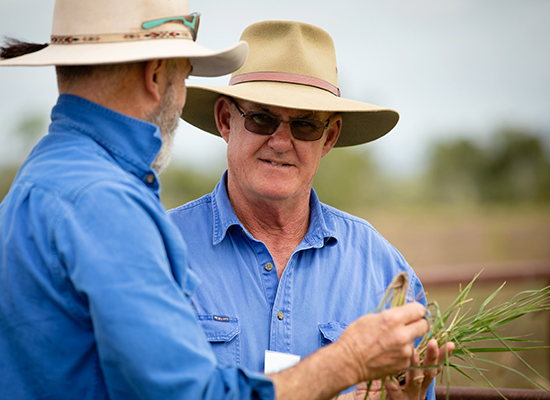
Dick Richardson (left) and grazier Bob Harris enjoying some “grass discourse”.
The improved pasture that had established included buffel, creeping blue grass, Rhodes, bambatsi, butterfly pea and desmanthus. The grazed site appeared to have healthier soil structure and biological activity than the ungrazed site, but both sites have improved ground cover while the gullies in both plots are stabilising.
The last stop of the field days was a 60ha alluvial gully complex that Greening Australia have spent several years working on.
A small NQ Dry Tropics demonstration plot was also inspected and it is using high numbers of livestock to try to re-establish some ground cover on a hostile bare area of about 1ha.
The initial massive germination and growth of weedy species such as button grass, pigweed and urochloa, with some germination of broadcast pasture seed, was overwhelmed by about 12 days of continuous rain in late January.
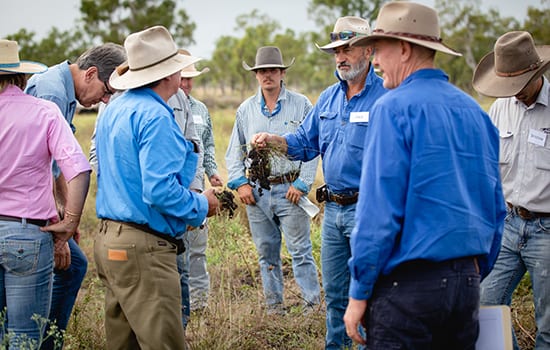
Dick Richardson
There was evidence that urochloa grass died during this period, possibly a combination of the harsh soil conditions and constant wet. On parts of the demonstration site and at adjoining Greening Australia remediation sites, Rhodes grass seemed to be the most likely species to get a foothold and there was a fair bit of Indian couch growing in places – it’s pretty tough.
Greening Australia’s Lynise Wearne outlined the large scale remediation program they have undertaken using mine reclamation techniques and heavy earthmoving machinery.
A quarry was opened not far from the site to provide rock capping as one of the options for stabilising the restored gully sites. A range of other options such as capping with recovered top soil and coir matting were also trialled.

